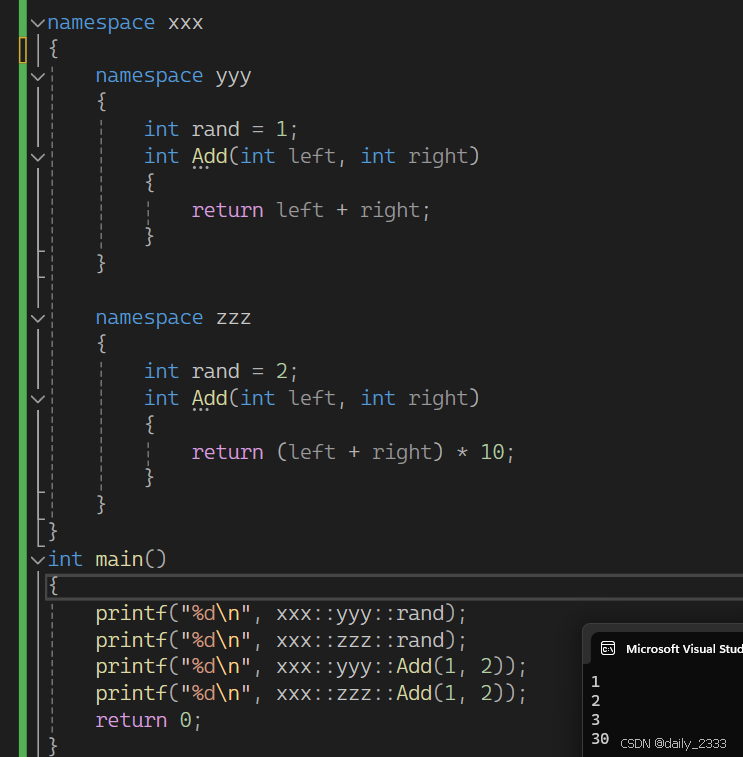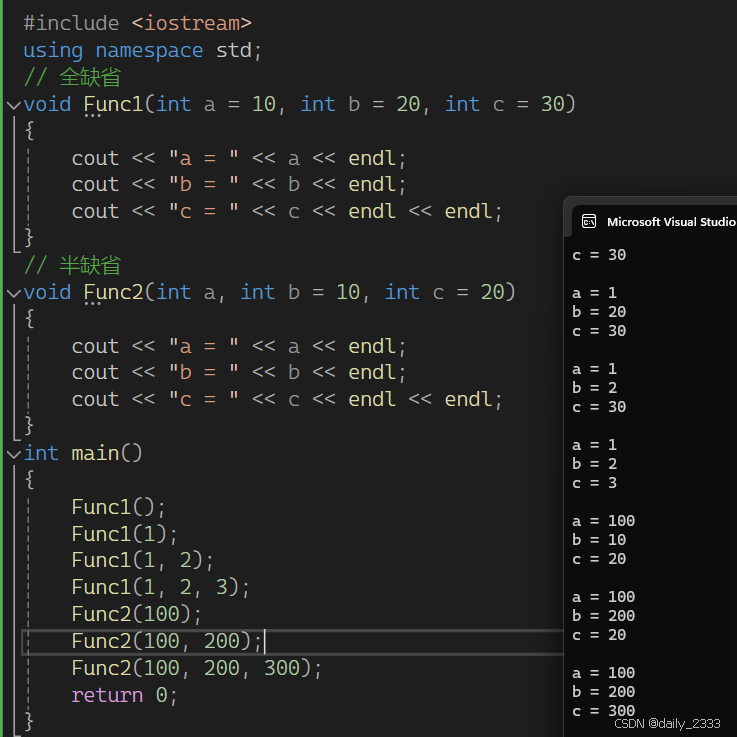
前言
今天小编带着大家进入c++的大门,虽然c++难,但好事多磨,一起来慢慢啃下这个硬骨头吧
今天大致会了解c++的入门基础部分,fellow me
一、c++的第一个程序
C++兼容C语言绝大多数的语法,所以C语言实现的hello world依旧可以运行,C++中需要把定义文件代码后缀改为.cpp,vs编译器看到是.cpp就会调用C++编译器编译,linux下要用g++编译,不再是gcc
// test.cpp
#include- 1
- 2
- 3
- 4
- 5
- 6
- 7
当然C++有一套自己的输入输出,严格说C++版本的hello world应该是这样写的。
#include- 1
- 2
- 3
- 4
- 5
- 6
- 7
二、命名空间
2.1 namespace 的价值
在C/C++中,变量、函数和后面要学到的类都是大量存在的,这些变量、函数和类的名称将都存在于全局作用域中,可能会导致很多冲突。使用命名空间的目的是对标识符的名称进行本地化,以避免命名冲突或名字污染,namespace关键字的出现就是针对这种问题的。\
c语言项目类似下面程序这样的命名冲突是普遍存在的问题,C++引入namespace就是为了更好的解决这样的问题
#include - 1
- 2
- 3
- 4
- 5
- 6
- 7
- 8
2.2 namespace 的定义
定义命名空间,需要使用到namespace关键字,后面跟命名空间的名字,然后接一对{}即可,{}中即为命名空间的成员。命名空间中可以定义变量/函数/类型等。
namespace本质是定义出一个域,这个域跟全局域各自独立,不同的域可以定义同名变量,所以下面的rand不在冲突了。
namespace xxx
{
namespace yyy // 嵌套定义
{
int rand = 1;
int Add(int left, int right)
{
return left + right;
}
}
namespace zzz
{
int rand = 2;
int Add(int left, int right)
{
return (left + right) * 10;
}
}
}
int main()
{
printf("%d\n", xxx::yyy::rand);
printf("%d\n", xxx::zzz::rand);
printf("%d\n", xxx::yyy::Add(1, 2));
printf("%d\n", xxx::zzz::Add(1, 2));
return 0;
}
- 1
- 2
- 3
- 4
- 5
- 6
- 7
- 8
- 9
- 10
- 11
- 12
- 13
- 14
- 15
- 16
- 17
- 18
- 19
- 20
- 21
- 22
- 23
- 24
- 25
- 26
- 27

有代码和运行截图,才能更好的理解
C++中域有函数局部域,全局域,命名空间域,类域;域影响的是编译时语法查找一个变量/函数/类型出处(声明或定义)的逻辑,所以有了域隔离,名字冲突就解决了。局部域和全局域除了会影响编译查找逻辑,还会影响变量的生命周期,命名空间域和类域不影响变量生命周期。
namespace只能定义在全局,当然他还可以嵌套定义。
项目工程中多文件中定义的同名namespace会认为是一个namespace,不会冲突。
C++标准库都放在一个叫std(standard)的命名空间中。
2.3 命名空间的使用
编译查找一个变量的声明/定义时,默认只会在局部或者全局查找,不会到命名空间里面去查找。所以下面程序会编译报错。所以我们要使用命名空间中定义的变量/函数,有三种方式:
• 指定命名空间访问,项目中推荐这种方式。
• using将命名空间中某个成员展开,项目中经常访问的不存在冲突的成员推荐这种方式。
• 展开命名空间中全部成员,项目不推荐,冲突风险很大,日常小练习程序为了方便推荐使用。
#include- 1
- 2
- 3
- 4
- 5
- 6
- 7
- 8
- 9
- 10
- 11
- 12
- 13
- 14
- 15
- 16
- 17
- 18
- 19
- 20
- 21
- 22
- 23
- 24
- 25
- 26
- 27
- 28
- 29
- 30
- 31
- 32
- 33
- 34
三、c++的输入和输出
• 是 Input Output Stream 的缩写,是标准的输入、输出流库,定义了标准的输入、输出对象。
• std::cin 是 istream 类的对象,它主要面向窄字符的标准输入流。
• std::cout 是 ostream 类的对象,它主要面向窄字符的标准输出流。
• std::endl 是一个函数,流插入输出时,相当于插入一个换行字符加刷新缓冲区。
• <<是流插入运算符,>>是流提取运算符。(C语言还用这两个运算符做位运算左移/右移)
• 使用C++输入输出更方便,不需要像printf/scanf输入输出时那样,需要手动指定格式,C++的输入输出可以自动识别变量类型,其实最重要的是
C++的流能更好的支持自定义类型对象的输入输出。
• IO流涉及类和对象,运算符重载、继承等很多面向对象的知识,我们后续会慢慢学习的,所以这里我们只能简单认识一下C++ IO流的用法。
• cout/cin/endl等都属于C++标准库,C++标准库都放在一个叫std(standard)的命名空间中,所以要通过命名空间的使用方式去用他们。
• 一般日常练习中我们可以using namespace std,实际项目开发中不建议using namespace std。
• 这里我们没有包含,也可以使用printf和scanf,在包含间接包含了。vs系列编译器是这样的,其他编译器可能会报错。
#include - 1
- 2
- 3
- 4
- 5
- 6
- 7
- 8
- 9
- 10
- 11
- 12
- 13
- 14
- 15
- 16
- 17
- 18
cin和cout用起来还是很爽的
四、缺省参数
缺省参数是声明或定义函数时为函数的参数指定一个缺省值。在调用该函数时,如果没有指定实参则采用该形参的缺省值,否则使用指定的实参,缺省参数分为全缺省和半缺省参数。(有些地方把缺省参数也叫默认参数)
全缺省就是全部形参给缺省值,半缺省就是部分形参给缺省值。半缺省参数必须从右往左依次连续缺省,不能间隔跳跃给缺省值。
带缺省参数的函数调用,C++规定必须从左到右依次给实参,不能跳跃给实参。
函数声明和定义分离时,缺省参数不能在函数声明和定义中同时出现,规定必须函数声明给缺省值。
#include - 1
- 2
- 3
- 4
- 5
- 6
- 7
- 8
- 9
- 10
- 11
- 12
#include - 1
- 2
- 3
- 4
- 5
- 6
- 7
- 8
- 9
- 10
- 11
- 12
- 13
- 14
- 15
- 16
- 17
- 18
- 19
- 20
- 21
- 22
- 23
- 24
- 25
- 26
- 27

可以仔细看看代码体会一下
还有一点要注意的是,缺省参数只能在函数的声明部分给,不能在定义部分给
// Stack.h .h文件 函数的声明 这里用以前实现过的栈举例子
#include - 1
- 2
- 3
- 4
- 5
- 6
- 7
- 8
- 9
- 10
- 11
- 12
// Stack.cpp 函数的定义文件
#include"Stack.h"
// 缺省参数不能声明和定义同时给
void STInit(ST* ps, int n) // 函数的定义 这部分不能给缺省值
{
assert(ps && n > 0);
ps->a = (STDataType*)malloc(n * sizeof(STDataType));
ps->top = 0;
ps->capacity = n;
}
- 1
- 2
- 3
- 4
- 5
- 6
- 7
- 8
- 9
- 10
// test.cpp 测试文件
#include"Stack.h"
int main()
{
ST s1;
// 不确定数据的多少,这里不传参数,函数会用默认参数
STInit(&s1);
ST s2;
// 确定知道要插入1000个数据,初始化时一把开好,避免扩容
STInit(&s2, 1000);
return 0;
}
- 1
- 2
- 3
- 4
- 5
- 6
- 7
- 8
- 9
- 10
- 11
- 12
五、函数重载
C++支持在同一作用域中出现同名函数,但是要求这些同名函数的形参不同,可以是参数个数不同或者类型不同。这样C++函数调用就表现出了多态行为,使用更灵活。C语言是不支持同一作用域中出现同名函数的。
参数类型不同
#include- 1
- 2
- 3
- 4
- 5
- 6
- 7
- 8
- 9
- 10
- 11
- 12
参数个数不同
void f()
{
cout << "f()" << endl;
}
void f(int a)
{
cout << "f(int a)" << endl;
}
- 1
- 2
- 3
- 4
- 5
- 6
- 7
- 8
参数顺序类型不同
// 3、参数类型顺序不同
void f(int a, char b)
{
cout << "f(int a,char b)" << endl;
}
void f(char b, int a)
{
cout << "f(char b, int a)" << endl;
}
- 1
- 2
- 3
- 4
- 5
- 6
- 7
- 8
- 9
需要注意一些情况
// 返回值不同不能作为重载条件,因为调用时也无法区分
void fxx()
{}
int fxx()
{
return 0;
}
- 1
- 2
- 3
- 4
- 5
- 6
- 7
// 下面两个函数构成重载
// f()但是调用时,会报错,存在歧义,编译器不知道调用谁 这里就是参数缺省背锅了
void f1()
{
cout << "f()" << endl;
}
void f1(int a = 10)
{
cout << "f(int a)" << endl;
}
- 1
- 2
- 3
- 4
- 5
- 6
- 7
- 8
- 9
- 10
六、nullptr
NULL实际是一个宏,在传统的C头文件(stddef.h)中,可以看到如下代码:
#ifndef NULL
#ifdef __cplusplus
#define NULL 0
#else
#define NULL ((void *)0)
#endif
#endif
- 1
- 2
- 3
- 4
- 5
- 6
- 7
C++中NULL可能被定义为字面常量0,或者C中被定义为无类型指针(void)的常量*。不论采取何种定义,在使用空值的指针时,都不可避免的会遇到一些麻烦,本想通过f(NULL)调用指针版本的f(int)函数,但是由于NULL被定义成0,调用了f(int x),因此与程序的初衷相悖。f((void)NULL);调用会报错。**
• C++11中引入nullptr,nullptr是一个特殊的关键字,nullptr是一种特殊类型的字面量,它可以转换成任意其他类型的指针类型。使用nullptr定义空指针可以避免类型转换的问题,因为nullptr只能被隐式地转换为指针类型,而不能被转换为整数类型。
#include- 1
- 2
- 3
- 4
- 5
- 6
- 7
- 8
- 9
- 10
- 11
- 12
- 13
- 14
- 15
- 16
- 17
- 18
- 19
- 20
- 21
所以c++部分尽量就用nullptr就好啦
七、inline
• 用inline修饰的函数叫做内联函数,编译时C++编译器会在调用的地方展开内联函数,这样调用内联函数就不需要建立栈帧了,就可以提高效率。
• inline对于编译器而言只是一个建议,也就是说,你加了inline编译器也可以选择在调用的地方不展开,不同编译器关于inline什么情况展开各不相同,因为C++标准没有规定这个。inline适用于频繁调用的短小函数,对于递归函数,代码相对多一些的函数,加上inline也会被编译器忽略。
也就是说,在inline这个方面,编译器占主导地位
• C语言实现宏函数也会在预处理时替换展开,但是宏函数实现很复杂很容易出错的,且不方便调试,C++设计了inline目的就是替代C的宏函数。
• vs编译器 debug版本下面默认是不展开inline的,这样方便调试。
• inline不建议声明和定义分离到两个文件,分离会导致链接错误。因为inline被展开,就没有函数地址,链接时会出现报错。
这里内联函数就是展开的,没有特别多的消耗,如果一个简短的函数调用次数很多很多,这个时候就可以用内联展开,减少函数栈帧的创建,提高效率
#include- 1
- 2
- 3
- 4
- 5
- 6
- 7
- 8
- 9
- 10
- 11
- 12
- 13
- 14
- 15
- 16
#include- 1
- 2
- 3
- 4
- 5
- 6
- 7
- 8
- 9
- 10
- 11
- 12
- 13
- 14
- 15
- 16
- 17
总结
今天入门了c++的基本语法,从第一个c++程序到命名空间对c语言命名冲突的优化,再来到缺省参数的魅力,然后是函数重载,接着是nullptr和NULL的区别以及优点,最后是类似于宏函数但优于宏函数的内联函数
c++在各个方面都在优化c语言,把以前不能实现或者有缺点的都进行了优化,不愧是c puls puls
今天的学习就到这里啦,下一篇博客小编将带着大家学习一个比指针好用的东西,不要走开,小编持续更新中~~~



评论记录:
回复评论: